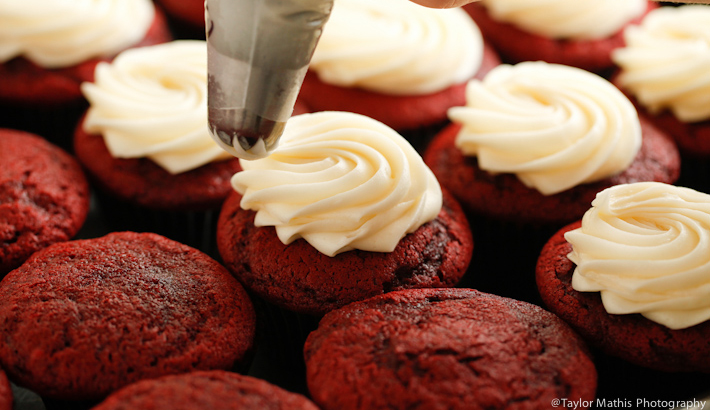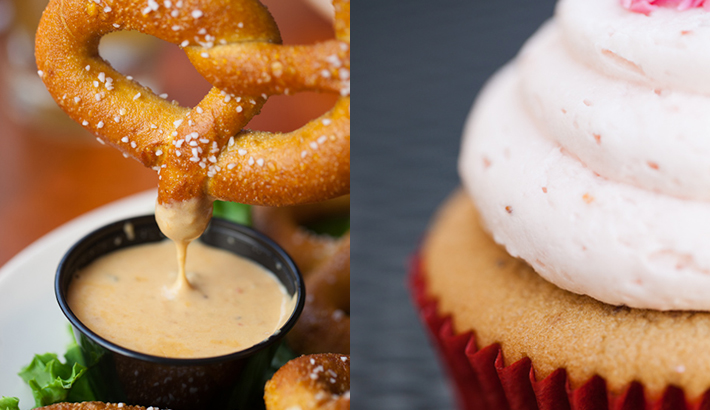What is the best lens? If you shoot wildlife, a long zoom lens will bring you close to the action but allow you to keep your distance so as not to startle your subject. If you shoot architecture, a tilt shift lens will allow you to make sure all the lines of your room or building are straight. Shooting weddings? You will most likely need a lens that can zoom for a variety of wide and close shots. When photographing food there is only one way to get those close up mouthwatering shots that your clients desire! Allow me to show you how a lens with macro capabilities will change how you shoot food!
A macro lens isn't just for wildlife photographers who like to shoot insects. Its ability to reproduce images at a 1:1 ratio is an essential feature to capture the close up detail that can create engaging food images. Shooting food with a long zoom lens is not the same as using a lens with macro capabilities. Below is an image showing a bowl of popcorn.

On the left is a shot of the popcorn taken with a Canon EF 70-200mm f/2.8L USM Telephoto Zoom Lens at 200mm at the lens's minimum focusing distance. On the right is the same bowl of popcorn taken with a Canon EF 100mm f/2.8L Macro IS USM Lens. As you can see, shooting with a long lens is not the same as using a lens with macro capabilities. With the 70-200, you have to be at minimum 4.6 feet away from the subject to focus. With the 100mm macro, you can be about a foot away. As you can see from the picture, you can capture far more detail with the macro lens than the 70-200mm lens.
4 feet away at 200mm is more than close enough for a shot of a person, but keep in mind that most food subjects are far smaller than a person's face. With food, you need to have the ability to get close to your subject and fill the frame like you would with a person's face. Macro will give you that ability!

In the garden, a macro lens will capture the small details of food and flowers as they grow.

Process and action shots are very popular in food photography. Whether it be a chef laying down a sauce on a plate or a baker icing a cupcake, there is beauty in their ability to perform these precise techniques in small places. With a macro lens, you can capture this detail.

With intricate dishes like sushi, a macro lens allows you to bring out the beautiful details.
Want to make someone hungry?


Seeing food up close and filling the frame will make that happen!
Just because you can go to a 1:1 magnification doesn't mean you have to. 1:2 or 1:3 magnification ratios will make your viewers hungry as well!

If you purchase a macro lens with a longer focal length, you will find that it will not only take great up close images of your food, it can work well as portrait lens for taking pictures of the people who make the food!

Will having a macro lens make you an amazing food photographer? No. Like all forms of photography, having expensive gear will not make you a great photographer. You will still need to know about styling, lighting, and composition to make beautiful food pictures. What a lens with macro capabilities will do is allow you to fill your frame with food shots and create compositions that you can't do with other lenses.
Interested in learning more about food photography styling and lighting techniques? Check out Issues 1-5 of photographing FOOD.







thats a nice tip....
but I also believe that there are other types of food photography that don't require macro lenses.... NatGeo photog Penny De Los Santos shoots food and lifestyle around the world with a 24-105mm lens.... her perspective is a bit different from a macro.... when we are including ingredients, props and other things around the food, we don't necessarily need a macro lens.... but for up-close shots, macro has no alternative....
24-105 L is a mighty versatile and under appreciated lens. That's the one lens I missed jumping over to Nikon. 24-120 and 24-85 here don't even come close to that quality
I take it you haven't seen how the 24-70mm performs? http://www.amazon.com/Nikon-24-70mm-2-8G-Nikkor-Angle/dp/B000VDCT3C
i take it that you don't realise it costs nearly 3 times as much and not quite the reach of the 24-105? (and probably lower magnification for product/food photography)
If anything a 2nd hand 28-70mm AF-S would be a better suggestion
Well, the Canon 24-105 L is actually more than half the Nikon 24-70mm, plus the magnification of the Nikon is actually better (Canon 1:4.34 vs Nikon 1:3.7). I do realize it costs more, but you get what you pay for.
hmm interesting find, didn't know about the mag nor the price either. I buy my gear 2nd hand and the 24-105 can be had for about S$7-800 from 5D mk2 bundles whereas the 24-70 often fetches S$2.2k 2nd hand too. Good to know.
The 24-105 has issues with fringing and sharpness, in my opinion. It's a darn fine lens but it's not suited for this kind of work (again, in my opinion).
its one of those lenses that has quite a range of variance. mine was excellent but I've seen a terrible copy of it with the problems you've mentioned too.
It is worth noting that, in addition to styling, lighting, and composition, a decent grasp of focus stacking can help make great shots as well.
You're very right. They work wonderfully at a fraction of the cost of a dedicated macro lens.
Wait... focus stacking is done in post, which costs nothing...
NCH, Focus Stacking isn't a "they", it's a "what"! http://fstoppers.com/how-to-use-photoshop-for-focus-stacking-multiple-im...
and FWIW, I wouldn't use f22 like Gavin did. Too much lens diffraction.
Your suggestion of close up filters is nowhere near the quality of a dedicated macro fixed focal length lens. Neither are zooms with wanna-be "macro" focus distances. Sorry!
The key word is $12. I don't know a single person who is a commercial food photographer. Yes, a real macro lens would be ideal, but for the rest of the photogs out there who want to photograph food for their blogs or other... i'm not sure many will complain about IQ or dedicated macro anything. :)
Sure, if it's just for 600 pixel sized images you're absolutely right. But until you try a real macro lens, don't knock it!
A 24-70L (in my case) takes fantastic close ups like these. So does my Sigma 50mm. Author, you might also want to mention that buying some macro rings does the same. For $12 bucks, you can do the same by stacking onto your existing lens with this cheap set. You can see identical shots on the amazon page- http://www.amazon.com/Digital-Concepts-cl-58-4-Piece-Multi-Coated/dp/B00...
Wait... so you buy a $2000 lens and then you block it with a $12 piece of glass? Tell me how that makes any sense.
Think you're missing the boat- feel free to buy a dedicated maco lens. But for other folks with normal lenses who don't or can't shell out money for the lenses the author uses, stacking lenses are a cheap alternative. Quality wise, they're the same - not when you blow it up at a higher resolution maybe, but for web photos, can you really spot what took which based on the photos in this article and the sample photos from the stackers on Amazon?
If we're talking about web photos, then just skip the DSLR (too bulky) and just bring along a point & shoot if your phone cam isn't good enough. You get better macro capabilities than you would with a $12 piece of glass. And it's cheaper than a $12 piece of glass in front of a $2k lens and a body to match.
It may not make sense, but I'll be damned if I don't laugh at that photo (and the fact that his user name is Nic Cage's Hair) every time he writes a comment.
my canon macro rings have no glass in them ;)
Really nice post! I am a Canon guy as well and havent played with the 100 macro but have the 60 macro which has worked well for me so far. Though its an EF-S lens its the only reason I really havent gone full frame.
Your 60mm on a 1.6x crop is basically the same focal length, but your missing the IS. I used to have the EF 50mm macro, but on full frame it's a bit too short and I was always physically too close. I have a few friends with the 180mm macro. That is an awesome lens.
mamiya 120mm macro converted to your ____ camera is great. real flat lens. i use mine for table top and portrait work. $800-900 used plus 40- 80 for converter.
I use a 24-105L & 5d MK 2 for the food shots. When I go in close I use the canon extension ring, which gets me in real close and gives the amazing shallow depth of field for a fraction of the price. I did consider the 100mm usm macro but a friend offered me the extender for next to nothing. I never did buy the 100mm.
I choose a Nikon 60 mm Micro over the 105 mm Micro. More micro isnt better. Sometimes i use the Nikkor 50 mm 1.2 w Close up Filter for better effects. Hope this helps
I have used a Sigma 70-200 f2.8, on my Canon bodies, which is also capable of macro, for food for great results. Being able to do both long and macro shots provides a greater degree of flexibility. Usually use either the 24-105 f4 on the other body or go for a wider angle lens, like the 17-40 if working in a tighter kitchen space.
I guess you guys have never heard of extension tubes? Delivers better IQ than crappy macro filters and big variety in what you can shoot depending on the combination of tubes you use.
And I'll take shelling out $65 over $900 any day.
Except you lose control over focus and aperture and lose some light as well. A tripod becomes a real necessity when working with tubes (as opposed to optional when working with a dedicated lens and/or filters. Not knocking your choice but each has its drawbacks and there are more affordable dedicated macro lenses that perform wonderfully (though not as cheap as filters or tubes).
Nice work Taylor.
This would have been a lot more helpful if there were some lense recommendations? Any ideas for good macros lenses for an amateur student budget? ;)
Sigma 70 or 105 are good choices. Very sharp and not too hard on the wallet. If you work with Canon, check out the 60 or 100 (has several versions but the L might be out of your budget. The non-IS, non-USM is the most affordable). Tamron's 90 is pretty good too.
Tamron 90mm macros are very very good
Hello my friend
Thanks for the article
I'm going to shoot my onlione Store
Which lens is good for my business?
I sell the scarf, and the scrave
Please to introduce me a cheap lens.
Hi Team Great article and comments also very good and give me more knowledge i have one small question with canon 6d kit lens 24-105 i purchased but i found its different 24-105 kit lens there is not red circle on kit lens ?
Other its 24-105 its good for food photography ? please advice and i have one more lens canon 50mm F1.8 it’s better than 24-105 kit lens
and i also need studio kit Visico is chines brand its good kit please advice
Thanks al ot